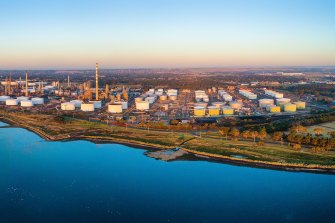Viva in ‘strong position’ to import LNG as shortfall looms
Fuel supplier Viva Energy says importing liquefied natural gas at the site of its Geelong oil refinery could avert winter gas shortages forecast to hit Victoria within years after the Andrews government blocked AGL’s $250 million import terminal plan.
In a blow to AGL’s hopes of developing the nation’s first liquefied natural gas (LNG) import terminal at Crib Point, the state’s Planning Minister Richard Wynne last week determined the project would have “unacceptable effects on the environment in Western Port, which is listed as a Ramsar wetland of international significance”.

The move leaves Victoria with fewer options to lift gas supplies for homes and businesses after the energy market operator renewed warnings of supply shortages from the winter of 2026.
As one of five remaining companies vying to develop LNG import terminals in Australia’s south-east, ASX-listed Viva Energy said it was “well-positioned” to deliver gas from its proposed project in Geelong ahead of projected shortfalls as Victoria’s legacy gas fields continued declining.
The company insists an LNG terminal at the Geelong refinery would be more cost-effective and less environmentally contentious than AGL’s rival Crib Point project, which attracted significant community and political resistance.
“Viva Energy believes that the proposed location of our terminal – adjacent to the Geelong refinery in an existing industrial area and working port – is a key advantage,” a spokesman said.
“The project is not located within a Ramsar wetland, and we intend to reuse seawater from the terminal, recycling it through the refinery and minimising the impact on the Corio Bay environment.”
Proposals to import natural gas – a fuel commonly used in heating, cooking, power generation and manufacturing – have been gaining attention in Victoria and NSW as governments and industry search for ways to bring down rising prices. While Australia is one of the world’s top shippers of LNG, most is produced in the nation’s north, far away from demand centres in the south-eastern states, and is sold on long-term contracts to overseas buyers.
The Australian Energy Market Operator (AEMO) has pushed back its forecast of winter gas shortfalls in south-eastern Australia from 2023 to 2026 on the basis that it expects Andrew “Twiggy” Forrest’s proposed LNG terminal at Port Kembla in NSW to proceed on schedule.
But shortages could still emerge from 2023 if the project is delayed, AEMO said, or if a demand spike due to a one-in-20-year cold snap led to greater strain on supply.
UBS energy and utilities analyst Tom Allen, who had anticipated Victoria’s rejection of AGL’s Crib Point proposal, said he expected AGL would seek to contract gas from Port Kembla.
“We expect AGL to procure 15-25 petajoules of gas supply via imported LNG from the Port Kembla LNG import terminal in NSW plus procure additional gas from Queensland, transported via pipeline into NSW and Victoria,” he said.
AGL chief executive Brett Redman said he was “reviewing and considering its position” on the government’s Crib Point verdict, but was open to striking a deal with one of the other companies vying to build LNG import terminals in south-eastern Australia.
Conservation groups said AEMO’s determination that Victoria had sufficient gas supply to last until 2026 gave the Andrews government more time to develop a strategy focused on reducing gas demand, such as switching appliances from gas to electric and prohibiting new residential gas connections.
“We can avoid damaging new gas supply projects like Crib Point and onshore drilling,” Environment Victoria campaigns manager Nick Aberle said.
Business reporter for The Age and Sydney Morning Herald.
Most Viewed in Business
Source: Thanks smh.com